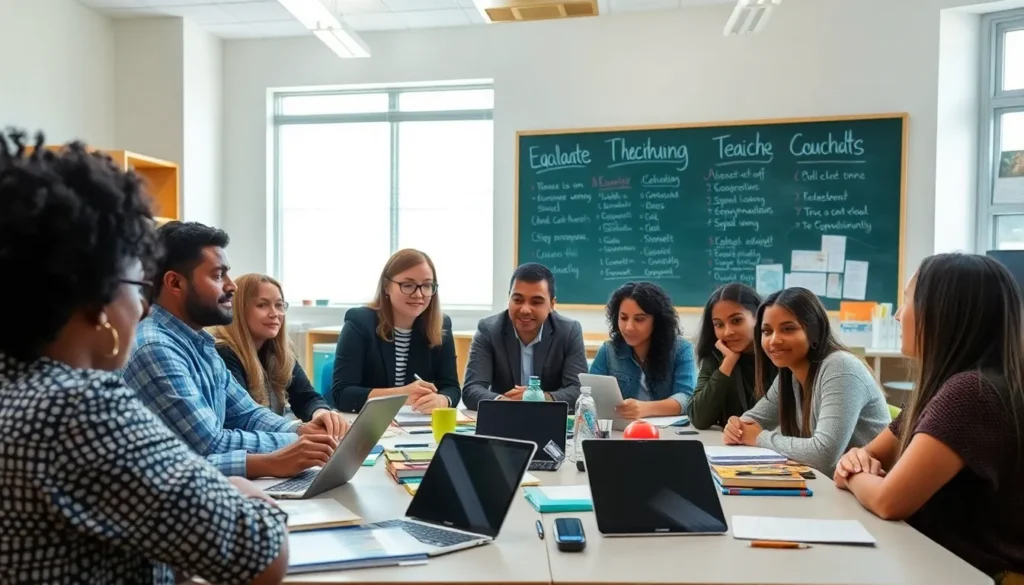Table of Contents
ToggleIn a rapidly changing world, educational reform stands at the forefront of discussions about the future of learning. As society evolves, so do the needs of students, teachers, and communities. Innovative approaches to education are essential to equip the next generation with the skills and knowledge they need to thrive.
This movement towards reform isn’t just about updating curricula or implementing new technologies; it’s about creating inclusive environments that foster critical thinking and creativity. By examining the challenges and opportunities within the current educational landscape, stakeholders can work together to shape a system that truly prepares students for the complexities of modern life.
Overview of Educational Reform
Educational reform encompasses a variety of initiatives aimed at improving the quality and effectiveness of education. Reform efforts focus on the curriculum, teaching methodologies, assessment practices, and overall school environment. These aspects interconnect to create a comprehensive approach that meets the diverse needs of students.
Key Objectives of Educational Reform:
- Enhancing Curriculum: Educational reform prioritizes updating curricula to reflect current knowledge and skills necessary for success in the workforce. This includes integrating STEM subjects, arts, and social-emotional learning.
- Improving Teaching Methods: Reform seeks to implement evidence-based instructional strategies that engage students. Professional development for educators plays a crucial role in fostering innovative teaching practices.
- Promoting Equity: A significant aim of educational reform involves creating equitable access to quality education for all students, regardless of socioeconomic background. This includes addressing disparities in funding and resources.
- Utilizing Technology: Reform encourages the effective integration of technology in classrooms to enhance learning experiences. Personalized learning through adaptive technologies caters to different learning styles and paces.
- Engaging Communities: Successful educational reform requires collaboration among educators, parents, and community leaders. Building partnerships helps ensure that reform initiatives align with local needs and values.
Current Trends in Educational Reform:
| Trend | Description |
|---|---|
| Personalized Learning | Tailoring educational experiences to meet individual student needs. |
| Project-Based Learning | Engaging students in collaborative projects that promote real-world skills. |
| Competency-Based Education | Focusing on student mastery of specific skills and knowledge before advancing. |
| Social-Emotional Learning | Integrating lessons on emotional intelligence and interpersonal skills. |
Educational reform drives innovation and adaptation within educational systems. By addressing the needs of diverse learners, reform initiatives enhance not just academic outcomes but also prepare students to thrive in society. Stakeholders—including policymakers, educators, and communities—must work together to ensure that reforms are effective and sustainable.
Historical Context of Educational Reform

Educational reform has evolved over centuries, responding to societal changes and shifting educational needs. Understanding historical reforms provides insight into current initiatives and guides future improvements.
Early Reforms
Early educational reforms began in the 19th century, influenced by industrialization and the demand for an educated workforce. The introduction of compulsory education laws, such as the Massachusetts statute in 1852, established the foundation for universal education. Horace Mann, often called the “Father of the American Public School System,” advocated for free public education, emphasizing structured curricula and trained teachers. Progressive movements in the early 20th century further addressed educational equity, advocating for child-centered learning and experiential education to meet diverse student needs.
Modern Developments
Modern educational reforms emerged in response to globalization and technological advancements. The 1983 report “A Nation at Risk” highlighted inadequacies in American education, prompting a focus on standardized testing and accountability measures. The No Child Left Behind Act of 2001 sought to ensure equitable access to education through high-stakes testing and performance metrics. Current trends include the integration of technology into classrooms, emphasizing personalized learning paths and competency-based education. The emphasis on social-emotional learning recognizes the importance of mental health and well-being in the educational process, fostering a holistic approach to student development.
Key Theories and Approaches
Educational reform incorporates various theories and approaches that shape effective practices in learning environments. Understanding these key frameworks helps educators, policymakers, and stakeholders implement meaningful improvements.
Progressive Education
Progressive education emphasizes student-centered learning, encouraging critical thinking and active participation. This approach prioritizes experiential learning, allowing students to engage with real-world problems. Notable proponents, such as John Dewey, advocate for democratic classrooms that foster collaboration and creativity. In progressive education, curricula adapt to students’ interests and needs, promoting individualized learning paths. Schools implementing this philosophy often adopt project-based learning and inquiry-driven activities, enhancing student engagement and retention.
Standardized Testing
Standardized testing, a prevalent method for assessing student performance, plays a significant role in educational reform discussions. These assessments provide measurable data to evaluate educational outcomes across diverse populations. Critics argue that over-reliance on standardized testing narrows curricula, limits creative teaching, and may disadvantage underserved student groups. Reform efforts are increasingly focusing on creating balanced assessment systems that incorporate multiple evaluation methods, including formative and authentic assessments. This shift aims to offer a more comprehensive view of student learning and ensure that educational reforms align with equitable and inclusive practices.
Impact on Students and Teachers
Educational reform significantly influences both students and teachers, promoting improved educational outcomes and teaching experiences.
Benefits of Educational Reform
Educational reform leads to numerous benefits for students and teachers.
- Enhanced Learning Environments: Reformed schools foster inclusive and safe spaces for students, encouraging participation and engagement.
- Personalized Learning: Educators can implement customized learning paths that address individual students’ strengths and needs, improving overall academic performance.
- Skill Development: Curriculums that incorporate 21st-century skills prepare students for future challenges, focusing on critical thinking, creativity, and collaboration.
- Teacher Empowerment: Reform initiatives often include professional development, allowing teachers to adopt innovative teaching methods and enhance their instructional skills.
- Increased Equity: Efforts to ensure equitable access to resources lead to improved educational opportunities for underrepresented groups, promoting fairness in the learning process.
Challenges Faced in Implementation
Implementing educational reform presents several challenges.
- Resistance to Change: Many educators and stakeholders may resist new methodologies due to comfort with traditional practices.
- Resource Allocation: Limited funding can hinder the ability to implement new initiatives effectively, impacting necessary training and materials.
- Policy Constraints: Existing regulations may create obstacles that limit flexibility in curriculum design and teaching methods.
- Assessment Alignment: Aligning new instructional strategies with standardized assessments poses difficulties, as traditional tests may not measure the intended outcomes of innovative practices.
- Stakeholder Engagement: Involving all stakeholders—teachers, parents, and community members—remains critical but often challenging in achieving consensus on reform approaches.
Case Studies of Successful Educational Reform
Case studies of successful educational reform provide valuable insights into effective strategies and practices. These examples showcase how targeted initiatives can enhance student learning and create supportive learning environments.
Example 1
The Finland education system exemplifies successful educational reform with its focus on equity and creativity. Finland abolished standardized testing in favor of a holistic approach that emphasizes well-being and student engagement. Teachers enjoy high autonomy, which encourages innovative teaching methods. This system has resulted in consistently high academic performance and well-rounded students, demonstrating that decreased pressure leads to improved outcomes. International assessments, like the Programme for International Student Assessment (PISA), consistently rank Finland among the top-performing countries in education.
Example 2
The Chicago Public Schools (CPS) implemented a turnaround model that transformed underperforming schools into successful learning environments. CPS focused on leadership development, teacher training, and community engagement. The initiative involved hiring experienced principals committed to fostering collaborative cultures, ensuring teachers received ongoing professional development. After three years of implementation, turnaround schools reported substantial improvements in test scores and graduation rates. The Chicago model highlights the importance of strong leadership and community input in driving educational success.
Educational reform is a vital process that shapes the future of learning. By fostering collaboration among stakeholders and embracing innovative practices, it can create environments where students thrive. The success of reform hinges on understanding the unique needs of diverse communities and adapting to the changing landscape of education.
As societies continue to evolve, the commitment to reform must remain steadfast. This journey requires ongoing dialogue and a willingness to embrace change. Ultimately, the goal is to equip students with the skills and knowledge they need to navigate an increasingly complex world, ensuring that education remains relevant and impactful for generations to come.







